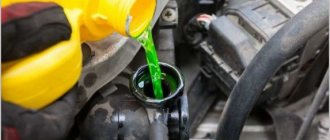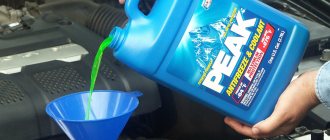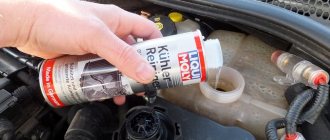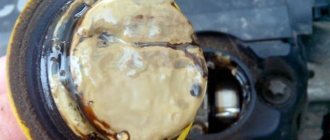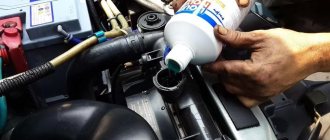Boiling antifreeze in the expansion tank in 90% of cases indicates engine overheating. If you don’t do anything, then there is a chance that you will end up with a jammed motor, the repair of which is not always advisable, and the cost of a new one will hit your pocket. So why does antifreeze boil in the expansion tank and what should you do if the temperature sensor does not indicate engine overheating?
Lack of antifreeze in the cooling system
Antifreeze, although slowly, still boils away; it has to be topped up periodically (2 - 3 times a year). Accordingly, the first step is to wait until the boiling stops, remove the cap of the expansion tank and add antifreeze (preferably the same brand as was previously used).
Some cars have 2 necks for filling antifreeze: through the expansion tank and the radiator. If the design is like this, then antifreeze is added to each of them up to the indicated marks (if there are none, then the instructions for the car contain recommendations from the manufacturer regarding the required volume of liquid in the cooling system).
Antifreeze leak
A lack of antifreeze in the system may indicate a coolant leak. In this case, after adding antifreeze, the engine can operate normally for 1–10 days, but then the problem returns again. Therefore, it would not be superfluous to conduct a detailed inspection of the pipes and connections to the expansion tank.
Leaks are often found on the radiator itself due to the appearance of cracks in it (it can only be eliminated by replacing it; it is recommended to install a copper one, although these are many times more expensive than aluminum ones).
Engine cooling system
First of all, I would like to understand in more detail how the engine is cooled. The system as a whole is not complicated, but there are some nuances in its operation. You need to understand that as soon as you start the car engine, it heats up intensely. It contains special channels through which coolant circulates under pressure and removes some of the heat. The main elements of the cooling system: radiators, pump, thermostat, expansion tank cap (air valve), pipes, etc.
The boiling point of antifreeze is higher than water. This is why it is used in modern cars. If we remember the physics course, we can conclude that an increase in pressure leads to an increase in the boiling point. Accordingly, the higher the pressure, the higher the temperature the coolant will boil. But heavy operating conditions (for example, standing in traffic jams) inevitably lead to a constant increase in pressure in the system. When it reaches a certain value, the air valve opens, thereby releasing excess steam into the atmosphere.
Thermostat is faulty
The car's cooling system is divided into 2 parts: a small and a large circuit. Antifreeze does not enter the large circuit until it warms up to 70 - 80 degrees. Next, a special valve opens (a thermostat that responds specifically to heating) and the coolant begins to circulate through the radiator.
If the thermostat is faulty, then antifreeze circulates only through a small circuit (which is not connected to the radiator). And the cooling of the antifreeze simply does not occur (the radiator is either completely cold or slightly warm). Because of this, the cooling system does not work properly and the engine overheats immediately after starting the engine.
How to check the functionality of the thermostat? If it is technically possible to remove it, then remove it and test it by placing the valve in hot water heated to approximately 90 degrees (the thermostat should “open”). If this does not happen, then the valve has definitely failed.
In cars where the thermostat cannot be removed, it is simply knocked out (since it was initially “pressed in”). Most likely, it will be damaged, so a similar procedure should be performed after purchasing a new thermostat in advance.
Increased pressure in the cooling system
The cooling system is closed. But when heated, the liquid expands and the internal pressure increases. In many cars, to normalize it, a check valve is installed, which dumps “excess” antifreeze into the expansion tank. At the moment when that same “reset” occurs, the antifreeze in the tank literally “gurgles,” which inexperienced drivers regard as boiling.
But if this happens too often, then this may indicate a malfunction of the reverse valve (clogged, it gets stuck). A temporary measure is to remove this valve altogether (by connecting the pipe directly to the tank). But you should still install it at the first opportunity.
How the cooling system works
Sometimes light bubbling, which occurs during normal operation of the cooling system, can be mistakenly mistaken for boiling. It has two circuits: a small one, which includes the engine water jacket, thermostat and furnace, and a large one, which passes through the main radiator. The antifreeze movement algorithm looks like this:
- until the engine warms up, only the small circuit works, there is a normal amount of liquid in the expansion tank;
- as it heats up, a large circulation circuit opens, the antifreeze heats up and increases in volume, enters the tank, the hole in the lid of which releases excess pressure;
- when the system heats up to a certain level, the liquid passes through the radiator, and the excess is discharged through its pipe. Sometimes at this moment it may feel like the antifreeze is boiling, when in reality it is not;
- When the engine cools, the pressure drops, the liquid decreases in volume, and air enters the system through the bypass valve.
Burnt through cylinder block gasket
One of the most difficult breakdowns that causes antifreeze to boil. Burning through the gasket leads to the fact that antifreeze begins to flow from the cooling system into the cylinder block, where it burns out and ends up in the exhaust system. This is often accompanied by thick white exhaust fumes. And at the same time, the level of antifreeze in the cooling system regularly drops to a minimum, although visible leaks cannot be detected.
With such a breakdown, traces of engine oil may also appear in the expansion tank - it is “sucked” from the cylinder block. After eliminating the malfunction, cleaning the cooling system is mandatory.
Repair involves disassembling the engine and replacing the damaged gasket. Naturally, this should only be done by a specialist, since it will be necessary to re-adjust the location of the valves, install the camshaft in the correct location, and so on.
What is the most common reason for gaskets to burn out? The key ones can be identified:
- natural wear and tear;
- incorrectly performed installation earlier (not tightened, threads of tightening bolts not lubricated, etc.);
- poor quality gasket;
- use of used gaskets;
- regular engine overheating.
In this situation, it is impossible to do without detailed diagnostics of the operation of motors.
Insufficient antifreeze level in the expansion tank
When there is not enough coolant in the system, the boiling point drops. In most cases, the problem is solved by regular topping up. It is advisable to perform it cold. This is due to the fact that at high temperatures the liquid expands. Therefore, if you fill the expansion tank to about 0, when the system cools, the amount of antifreeze will become significantly less.
Actually, there is nothing complicated about topping up. We find the expansion tank and unscrew the plug. It can be either ordinary plastic, which performs practically no function, or sealed. After we unscrew it, fill in the required amount of antifreeze. It is advisable that the antifreeze level in the expansion tank be between o and “minimum”. As for the reasons why the level dropped, there are only a few of them. It is likely that the system was not topped up with antifreeze. The second option is a leak.
Pump faulty
The circulation of the coolant is ensured by a circulating pump (pump), which is driven either by a belt drive or by an electric motor. If the pump stops pumping antifreeze, then it simply will not have time to cool, flowing through the radiator. As a rule, with such a breakdown, the “Check” signal lights up on the dashboard. Repair - replacing the pump with a new one.
In engines where the pump is driven by a belt drive (found mainly in older cars), you should also check that the belt is not slipping. This can occur due to the ingress of oil, antifreeze, or water (in rainy weather).
Fan doesn't work
The fan is installed behind the radiator and creates a powerful air flow, which cools the coolant flowing through it. If it is faulty or does not turn on (because the temperature sensor has failed), then the radiator will not be ventilated enough, and accordingly, the engine temperature, although slowly, will rise to a critical level of over 110 degrees. This happens mainly in the warm season, since in winter and without a fan the radiator will cool normally at average engine loads.
Repair - either replacing the fan or temperature sensor. As a temporary measure, you can consider removing the temperature sensor and connecting the impeller directly to 12V (to the battery). In this case, it will work continuously without turning off (only when the ignition is on).
Air blockage
If air gets into the cooling system, a pneumatic plug is formed, due to which antifreeze simply does not circulate through the radiator. Mostly this occurs when small holes appear in the pipes or in the radiator itself (air is “sucked in” through them). In this case, antifreeze almost immediately boils in the expansion tank after starting the engine.
Repair involves eliminating the hole; the easiest way to find it is through a thorough inspection of the cooling system with the engine running. It is necessary to find exactly where the liquid is leaking.
You may also be interested
Why does antifreeze turn brown or rusty?
If the antifreeze turns brown, this is a reason to check the performance of the cooling system components, as well as the quality of the mixture itself. Checking several factors at once will help you figure out why the liquid has changed color. Read more in the article on our website.
Why does antifreeze foam and foam form in the expansion tank?
A car with poor heat dissipation from the engine is sensitive to any overheating. If the antifreeze foams, this indicates problems with its composition and requires attention from the car owner. Let's talk to experts about what to do in this situation.
Low ambient pressure
You may encounter something similar while traveling. The fact is that the higher the car is above sea level, the lower the boiling point of the coolant. These are the simplest laws of physics, known from school.
If at an altitude of 0 meters above sea level the boiling temperature is in the range of 100 - 110 degrees, then at an altitude of 2.5 - 3 km antifreeze will begin to boil at 85 - 90 degrees. But the engine should not overheat. This is not a breakdown, but a natural behavior of the coolant.


